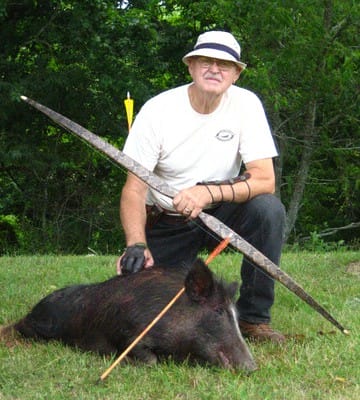
I started bow hunting when I was 14 years old. Mom and dad picked up an old Ben Pearson recurve bow and a quiver full of mismatched arrows at a yard sale and I spent all summer practicing. Admittedly, I was not a very good shot much beyond 10 yards but I was completely immersed—every day after school the first thing I would do was shoot that bow.
I fitted some broadheads to several of the arrows that looked the like they matched and thought I was ready when opening day arrived. I missed six deer in as many days. While this might seem enough to discourage anyone, I found the exhilaration of letting the deer come in close the most exciting hunting experience I had ever been part of. Determined to succeed, I talked my parents into getting me a compound bow for Christmas.
They did and my shooting immediately improved. I could routinely hit a snuff can out to 35 yards. When archery season arrived I had a quiver full of confidence managed to actually connect with two deer but was unable to find either of them. For the next five years I continued to acquire better and more technologically advanced equipment and I did take a few deer but my success never equaled the money I spent and it wasn’t long until I gave up bowhunting all together.

A few years later, just released from active duty, I was on my way back from Idaho. At a Boise gas station I picked up a magazine about hunting with traditional archery equipment. That magazine rekindled some of the passion I had enjoyed with my first bow so I saved some money and ordered a new recurve and some wooden arrows. I haven’t looked back sense.
It’s not uncommon for modern bowhunters to consider traditional archery equipment less than sufficient for hunting. Nothing could be further from the truth. I’ve learned that with bowhunting, shot placement and sharp broadheads are what puts meat in the freezer and heads on the wall. I’ve taken near two dozen deer with a recurve bow and in most cases the arrow completely passed through and the deer went down within sight of my stand. A few years back I got a friend interested in traditional gear and he even took a buck with a homemade bow and an arrow fitted with a flint head.
Traditional bows are much lighter than modern compounds and because they lend themselves to instinctive shooting, they are faster to get on target and release. They also require much less maintenance and fewer accessories. Because of their light weight and compactness—many traditional bows are of the takedown variety—they are perfectly suited to hunts that require a long hike to reach your destination. There’s also that sense of nostalgia or Fred Bear connection that comes with hunting with a recurve or long bow.
If you think it is something you might like to try, here are some suggestions for anyone interested in traditional archery:
Traditional archery clubs exist all across the U.S and it’s been my experience that their members are very receptive to anyone interested in learning about the sport. The shoots these clubs host are a great place to try several different styles of bows and pick up some advice on equipment before you break out the VISA card.
Many compound shooters think because they can handle a 70-pound wheeled bow they can just as comfortably handle a 70-pound traditional bow. I learned this the hard way. When selecting a first traditional bow I would strongly suggest you reduce your compound draw weight by at least 20 percent.
Modern bowhunters routinely assume that you must shoot wooden arrows from traditional bows. Often, traditional archers use wooden arrows because of nostalgia and because the added weight helps with penetration. But when properly tuned, aluminum or fiber arrows will fly exceptionally well from a recurve or a long bow.

There is a difference in a recurve bow and a long bow. With a long bow, the string is never in contact with the flat of the limb. With a recurve, the string will lay in a groove along the flat of the limb near the tip.
Just as with compound bows but more exaggerated with traditional bows, the longer the bow the easier it will be to shoot.
Penetration is key regardless of the bow and arrow you hunt with but it has been my experience that cut-on-contact broadheads are much more effective, especially at the lower velocities produced by traditional archery equipment.
Practice, practice and practice some more—that’s the key to shooting instinctively. Establish the maximum range where you can keep all your shots inside a six inch circle and never shoot beyond that range at an animal. Unlike shooting a bow equipped with sights, instinctive shooting requires constant and dedicated reinforcement.
There are not a lot of contemporary sources for information on hunting and shooting with traditional archery gear. There are however several good, older books discussing the sport. Traditional Bowhunter magazine, www.tradbow.com, is the only periodical dedicated to hunting with traditional archery equipment and there you can find a wealth of knowledge from experienced bowhunters, in just a year’s worth of issues.
I doubt I will ever hunt with a compound bow again. Don’t get me wrong, I have nothing against compound bows or hunters that use them. For me the spirit of bowhunting is found with the stick and string and I would encourage anyone that hunts with a compound to give it a try. You may find a new passion and at worst your experiences with a traditional bow may make you a better shot and hunter when using one of those modern bows with the training wheels.







